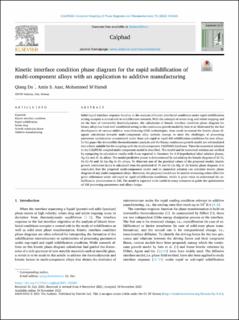| dc.contributor.author | Du, Qiang | |
| dc.contributor.author | S. Azar, Amin | |
| dc.contributor.author | M'hamdi, Mohammed | |
| dc.date.accessioned | 2022-08-16T06:56:46Z | |
| dc.date.available | 2022-08-16T06:56:46Z | |
| dc.date.created | 2022-05-06T13:28:14Z | |
| dc.date.issued | 2022 | |
| dc.identifier.citation | Calphad. 2022, 76 1-16. | en_US |
| dc.identifier.issn | 0364-5916 | |
| dc.identifier.uri | https://hdl.handle.net/11250/3011994 | |
| dc.description.abstract | Solid-liquid Interface response function or the analysis of kinetic interfacial conditions under rapid solidification setting occupies a central role in solidification research. With the concepts of solute drag and solute trapping and on the base of irreversible thermodynamics, the calculation of kinetic interface condition phase diagram for binary alloys has been well established owing to the continuous growth model by Aziz et al. Motivated by the fast development of various additive manufacturing (AM) technologies, clear needs to extend the kinetic phase diagram calculation towards multi-component alloy systems emerge to meet the challenges of processing parameter optimization encountered under those sub-rapid or rapid AM solidification conditions for new alloys. In this paper the irreversible thermodynamics analysis and the binary continuous growth model are reformulated into a form suitable for the coupling with the multi-component CALPHAD databases. Then the numerical solution to the CALPHAD-coupled multi-component model is described. The model and its numerical solution are verified by comparing its calculation results with those reported in literature for A-B hypothetical ideal solution phases, Ag–Cu and Al–Be alloys. The model predictive power is demonstrated by calculating the kinetic diagram of Al–Ti, Fe–Cr–Ni and Al–Cu–Mg–Si–Zn alloys. To illustrate one of the practical values of the proposed model, kinetic growth restriction factor is calculated from the predicted Al–Ti and Al–Cu–Mg–Si–Zn kinetic phase diagram. It is concluded that the proposed multi-component model and its numerical solution can calculate kinetic phase diagram of any multi-component alloys. Moreover, the proposed model can be used in evaluating solute effect for grain refinement under sub-rapid or rapid solidification conditions, which is great value to understand the solidification phenomenon in AM. The model is expected to be useful in many scenarios to guide the optimization of AM processing parameters and alloys design. | en_US |
| dc.language.iso | eng | en_US |
| dc.publisher | Elsevier | en_US |
| dc.rights | Navngivelse 4.0 Internasjonal | * |
| dc.rights.uri | http://creativecommons.org/licenses/by/4.0/deed.no | * |
| dc.subject | Additive manufacturing | en_US |
| dc.subject | Growth restriction factor | en_US |
| dc.subject | Solute drag | en_US |
| dc.subject | Rapid solidification | en_US |
| dc.subject | Kinetic interface condition | en_US |
| dc.title | Kinetic interface condition phase diagram for the rapid solidification of multi-component alloys with an application to additive manufacturing | en_US |
| dc.title.alternative | Kinetic interface condition phase diagram for the rapid solidification of multi-component alloys with an application to additive manufacturing | en_US |
| dc.type | Peer reviewed | en_US |
| dc.type | Journal article | en_US |
| dc.description.version | publishedVersion | en_US |
| dc.rights.holder | © 2021 The Authors. Published by Elsevier Ltd | en_US |
| dc.source.pagenumber | 1-16 | en_US |
| dc.source.volume | 76 | en_US |
| dc.source.journal | Calphad | en_US |
| dc.identifier.doi | 10.1016/j.calphad.2021.102365 | |
| dc.identifier.cristin | 2022124 | |
| dc.source.articlenumber | 102365 | en_US |
| cristin.ispublished | true | |
| cristin.fulltext | original | |
| cristin.qualitycode | 1 | |

